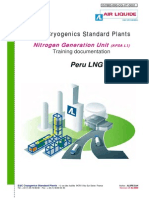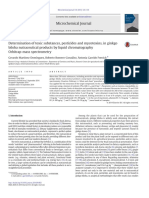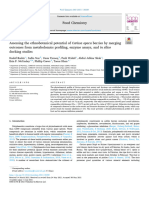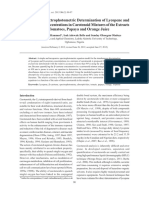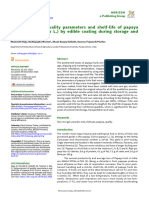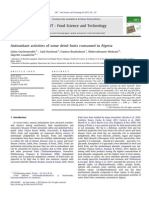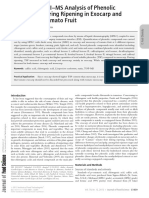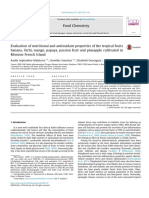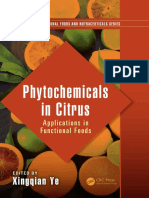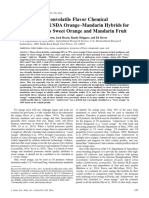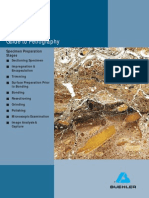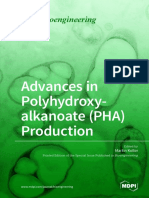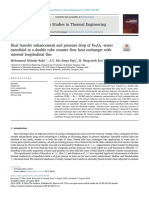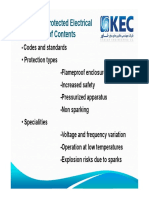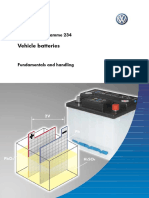Stability of Carotenoids in Dried Apricots Prunus
Stability of Carotenoids in Dried Apricots Prunus
Uploaded by
lunosicaCopyright:
Available Formats
Stability of Carotenoids in Dried Apricots Prunus
Stability of Carotenoids in Dried Apricots Prunus
Uploaded by
lunosicaOriginal Description:
Original Title
Copyright
Available Formats
Share this document
Did you find this document useful?
Is this content inappropriate?
Copyright:
Available Formats
Stability of Carotenoids in Dried Apricots Prunus
Stability of Carotenoids in Dried Apricots Prunus
Uploaded by
lunosicaCopyright:
Available Formats
Stability of Carotenoids in Dried Apricots (Prunus
Armeniaca L.) During Storage
Elena Andreea POP1, Andrea BUNEA1, Florina COPACIU1, Carmen SOCACIU1, Adela PINTEA1*
University of Agricultural Sciences and Veterinary Medicine Cluj-Napoca, Mănăștur 3-5, 400372, Cluj-
Napoca, Romania
*corresponding author: apintea@usamvcluj.ro
Bulletin UASVM Food Science and Technology 73(2) / 2016
ISSN-L 2344-2344; Print ISSN 2344-2344; Electronic ISSN 2344-5300
DOI: 10.15835/buasvmcn-fst:12263
Abstract
Apricots are well known for the high content of bioactive compounds such as carotenoids, polyphenols, vitamins
and minerals. Several studies have pointed out the chemical composition or the biological effects of apricots, but
limited information are available regarding the stability of active compounds during storage or processing. The
aim of this study was to determine the stability of major carotenoids in commercial dried apricots during storage.
Carotenoids were extracted monthly from dried apricots kept in a dark environment, at room temperature, for
twelve months. Total carotenoids were determined using the spectrophotometric method while the most relevant
carotenoids were analyzed by high-performance liquid chromatography-photodiode array detection (HPLC-PDA)
on a C30 column and using a gradient elution system.
Initial carotenoid content of dried fruits was 6.72 mg/100g, while after six months of storage it decreased to
2.46 mg/100g. After twelve months of storage the total carotenoid content was 0.82 mg/100g, representing 20.35
% of the initial concentration. The major carotenoids identified in apricots were: all trans β-carotene, its geometrical
isomers (9-cis-β-carotene; 13-cis-β-carotene; 9,13-di-cis β-carotene); β-carotene-5,8-epoxide; β-cryptoxanthin
and β-cryptoxanthin palmitate. Significant decreases were observed for all pigments but all trans β-carotene
appears to be the most sensitive pigment, with 15.7 % residual concentration. Although the concentrations of
β-cryptoxanthin palmitate is small, it has shown significant increased stability compared to carotenes.
Keywords: apricots, carotenoids, HPLC, stability
INTRODUCTION tissues exposes carotenoids to light, oxygen and
Food which provide high carotenoid intake oxidizing enzymes like lipoxygenase (Britton
are considered very important to maintain health et al., 1995a; Mercadante, 2008; Caris-Veyrat,
and to reduce the risks of severe diseases (Krinsky 2008). The mechanisms involved in carotenoids
and Johnson, 2005). The carotenoid content degradation in food are similar with the degrada
in plant derived food is influenced by several tion of pure compounds and occur mainly through
factors such as: genetic origin, environmental oxidation, geometrical isomerisation, but also by
conditions, cultivation practice and post-harvest rearrangement of 5,6-epoxides and dehydration
treatment. Post-harvest treatment is a key step in (Mercadante, 2008; Rodriguez-Amaya, 2016).
preserving the nutritional value of plant food. Due Enzymic oxidation is due to the contact of caro
to the polyenic system (conjugated double bonds), tenoids with lipoxygenase which leads to the
carotenoids are susceptible to degradation under bleaching of pigments, while non-enzymic oxida
high temperature, light, acidic pH and presence tion results in the formation of different epoxides
of reactive oxygen species. It was proved that and apocarotenals. High temperature, light and
carotenoids are more stable in vegetables and presence of acids determine the geometrical
fruit than in isolated form and disruption of the isomerisation of carotenoids (Mercadante, 2008).
94 POP et al
Apricots are largely consumed worldwide as 2.3 Separation of carotenoids by RP-HPLC
fresh, canned or dried fruits. The total world fresh HPLC analysis of carotenoids was performed
apricot production was 4,038,520 tons in 2012, on Shimadzu LC20 AT high performance liquid
with Turkey as main producer of both fresh and chromatograph with a SPDM20A diode array
dried fruits (FAOSTAT). Due to the short shelf life detector. An YMC C30 column (250x4.6 mm; 5
of fresh apricots, these are subjected to different μm) was used and the mobile phases consisted
preservation methods, the most common being in: solvents A: methanol/tert-butyl methyl ether/
canning or drying (open air sun drying, hot air water (81:15:4) and solvent B: tert-butyl methyl
drying, microwave drying or combined methods) ether/methanol/water (90: 7:3). The gradient
(Garcia-Martinez et al., 2012). Beside their was: 0 min 0 % solvent B, 20 min 0 % B; 130 min –
pleasant taste, apricots are associated with health 82 % B; 132 min 0 % B, followed by equilibration
benefits such as anti-inflammatory, antioxidant or of column for 10 min. The flow rate was fixed at 0.8
antimicrobial effects (Erdogan-Orhan and Kartal, ml/min and the DAD detector was set at 450 nm.
2013). Carotenoids, polyphenols, vitamin C, Standard compounds β-cryptoxanthin, β-carotene
mono- and polysaccharides, volatiles and minerals and lycopene were provided by ChromaDex, USA;
are among the most important constituents of β-cryptoxanthin palmitate was obtained by semi
apricot fruits (Ruiz et al., 2005; Sass-Kiss et al., synthesis and purified by HPLC in our laboratory
2005; Dragovic-Uzelac et al., 2007; Aubert and (Pintea et al., 2013). The chromatographic data and
Chanforan, 2007; Kurtz et al., 2008; Erdogan- UV-VIS spectra were compared using Shimadzu
Orhan and Kartal, 2013). Even if several studies LC software. Calibration curves were made
investigated the effect of drying method on the for β-cryptoxanthin, β-carotene and β-crypto
total and individual content of carotenoids in xanthin palmitate by plotting peak area against
apricots (Ihns et al., 2011; Garcia-Martinez et concentration. The identification of cis isomers
al., 2012; Turkyilmaz et al., 2013; Fratianni et was based on the specific absorption maxima
al., 2013) there are no reported data regarding which appears in the UV region of the absorption
the stability of individual carotenoids in dried spectra of carotenoids (Britton et al., 1995b).
apricots during storage. Our aim was to monitor Statistical analysis. The results are presented
the carotenoid content and profile during one year as the mean ± SD. Significant differences between
storage period of commercially available dried samples were analysed with one-way ANOVA post
apricots using an HPLC-PDA method. hoc tests, and pairwise multiple comparisons
were onducted using Tukey’s test. Significant
differences were reported based on P ≤ 0.05.
MATERIAL AND METHODS Statistical analyses were performed using the
2.1 Plant material SPSS programme (SPSS Inc., Chicago, IL, USA).
Dried apricots (Prunus armeniaca L.) were
purchased from a local organic product store. The RESULTS AND DISCUSSIONS
fruits were divided and kept in individual sealed The total carotenoid content, estimated by
polyethylene bags, at room temperature (25ºC), in the spectrophotometric method in dried apricots
dark for twelve months. Samples were taken each at the beginning of the experiment was 6.72
month for carotenoid extraction. mg/100 g. This value is relatively low compared
2.2 Carotenoid extraction and quantification to fresh fruits, where a total carotenoid content
The dried fruits (20 g) were extracted with ranging between 1.5-16 mg/100 g fresh weight
a mixture of methanol/ethyl acetate/ petroleum was reported for various cultivars (Ruiz et al.,
ether (1: 1: 1, v/v/v) as described previously 2005; Sass-Kiss et al., 2005; Dragovic-Uzelac et
(Pop et al., 2015). Total carotenoids content al., 2007; Kurtz et al., 2008). Taking into account
was determined using the spectrophotometric that β-carotene is the major compound in
method with an UV-VIS Spectrophotometer (Jasco apricots, the carotenoid concentration is close to
V-530) (Britton et al., 1995a). The concentration values found by Alagoz et al. (2015), 4.1- 6.7 mg
of total carotenoids was expressed as mg β-carotene/100 g in dried apricots from Turkey.
carotenoids/100 g dried fruits. All experiments Higher concentrations of β-carotene (10.4-12.8
were performed under subdued light. mg/100 g d.w), were found in dried apricots (with
Bulletin UASVM Food Science and Technology 73(1) / 2016
Stability of Carotenoids in Dried Apricots (Prunus armeniaca L.) During Storage 95
0.6 0.5
0.4
0.4
0.2
Abs 0.2 Abs
0 0
-0.1 -0.1
300 400 500 550 300 400 500 550
Wavelength [nm] Wavelength [nm]
(a) (b)
0.4 0.3
0.3
0.2
0.2
0.1
Abs Abs
0.1
0
0
-0.1 -0.1
300 400 500 550 300 400 500 550
(c) Wavelength [nm]
(d) Wavelength [nm]
Figura 1. Absorption spectra of total carotenoid extract in dried apricots
(a) December 2014; (b) April 2015; (c) September 2015; (d) November 2015.
Fig 2. Variation of total carotenoids in dried apricots during storage
~25 % water content) obtained from a Spanish decrease of absorption at λmax 448 nm and an in
cultivar by different drying methods (Garcia- crease of absorption in the UV region (300-400
Martinez et al., 2012). Also, Türkyilmaz and nm). These changes are associated with a decrease
coworkers (2013) found concentrations ranging of carotenoid concentration and with changes in
between 26.6 and 36.2 mg/ 100 g d.w. depending the profile of carotenoids, mainly with the cis-
on SO2 content in one cultivar of dried Turkish trans isomerization and appearance of “cis-peak”
Malatya apricots. As it can be observed in Figure (Britton et al., 1995b).
1, significant changes occurred in the absorption A significant decrease of total carotenoid
spectra of total carotenoid extract, with a marked during storage can be observed (Figure 2), from
Bulletin UASVM Food Science and Technology 73(1) / 2016
96 POP et al
the initial value of 6.72 mg/100 g to 0.82 mg/100 The variation of major carotenoids in dried
g after twelve months of storage. Considering apricots is shown in Table 1, where data are
these data, only 20 % of the initial amount of expressed as % residual carotenoid compared
carotenoids can be found after one year of storage to intitial concentration (considered as 100 %).
at room temperature. The degradation rate seems During the storage of fruits, loss of all carotenoids
to be more intense in first seven months (1.96 could be observed but the extent of degradation
mg/100 g) and slower in the last period of storage. depends on the nature of the carotenoid. After
The profile of carotenoids in dried apricots is twelve months of storage, the highest degradation
similar with that found in fresh fruits (Pop et al., was recorded for all trans β-carotene, followed
2015). As previously reported, all trans β-carotene by its cis isomers. A possible explanation could be
is the major carotenoid in fresh or dried apricots, that all trans β-carotene was partially converted
followed by its geometric isomers (13-cis-β- into cis-isomers which represents one of the
carotene; 9,13-di-cis β-carotene; 9-cis-β-carotene). mechanism of carotenoid degradation in food.
In lower amounts, β-carotene-5,8-epoxide, β-cryp The ester of β-cryptoxanthin with palmitic acid
toxanthin, β-cryptoxanthin esters and lutein was less affected than the corresponding free
are present. A similar profile of carotenoids was xanthophyll (β-cryptoxanthin) and significantly
reported by Kurtz et al. (2008). more stable than β-carotene and its isomers.
5
200
6
150
Intensity (mAU)
3
100
4
50 2
1
7
0
0 20 40 60 80 100 120 140
(a) Retention time (min)
5
200
150
Intensity (mAU)
100 6
3
50
4
12 7
0
20 40 60 80 100 120 140
(b) Retention time (min)
Fig. 3. HPLC/PDA chromatograms of carotenoids from dried apricots (a) – Month 1; (b) – Month 7.
(1) β-cryptoxanthin, (2) β-carotene-5,8-epoxide ; (3) 13-cis-β-carotene; (4) 9,13-di-cis β-carotene (5) all trans
β-carotene; (6) 9-cis-β-carotene; (7) β-cryptoxanthin palmitate
Bulletin UASVM Food Science and Technology 73(1) / 2016
Stability of Carotenoids in Dried Apricots (Prunus armeniaca L.) During Storage 97
Tab. 1. Variation of residual concentration of major carotenoids (mean ± S.E) in dried apricots during
storage
Compound Month 1 Month 4 Month 8 Month 12
β-cryptoxanthin 97.2 ± 5.7a 75.2 ± 4.2b 45.0± 2.3c 37.2 ± 2.3c
13-cis β-carotene 97.1 ± 3.8a 71.3 ± 3.5b 38.8 ± 2.1c 25.4 ± 1.5d
all trans β-carotene 95.5 ± 3.8a 57.4 ± 1.5b 25.4 ± 0.9c 15.7 ± 1.4d
9-cis β-carotene 98.3 ± 3.7a 67.3 ± 3.4b 39.1 ± 1.5c 27.3 ± 1.7d
β-cryptoxanthin palmitate 98.4 ± 4.3a 85.2 ± 4.1b 61.4 ± 2.4c 58.2 ± 3.3c
Note: Different letters within a column denote significant differences (P < 0.05).
A study performed on different fruits and esterified form of xanthophylls - β-cryptoxanthin,
vegetables monitored the changes induced by lutein, zeaxanthin, capsanthin and capsorubin –
thermal treatment (heating at 98ºC) or freezing showed increased thermal and storage stability
(-20ºC) on the content of anthocyanins, carotenoids compared to their non-esterified counterparts in
and ascorbic acid. In the case of apricots, the paprika (Schweiggert et al., 2007) and tamarillo
concentration of individual carotenoids was nectar (Mertz et al., 2010).
estimated spectrophotometrically based on the
wavelength of maximum absorption and on CONCLUSIONS
their molar absorptivity coefficients, without a In the present work, we demonstrated that
chromatographic separation. Using this method significant losses in total carotenoid content occurs
the authors have shown that the highest decrease during the storage of dried apricots, only 20.35 %
was produced by lyophilization, for all carotenoids of the initial concentration remaining after twelve
the final concentration being approximately 50% of months. This is the first report regarding the
the initial one. Heating at 98ºC resulted in a greater comparative stability of carotenes, xanthophylls
reduction of hydrocarbon carotenoid (β-caro and their esters in dried apricots, by using an
tene, α-carotene and lycopene) and a moderate HPLC method. The degree of degradation depends
fall in the case of xanthophylls (β-cryptoxanthin on the chemical nature of compounds, β-carotene
and lutein) (Leon et al., 2012). In the case of sun being more sensitive than β-cryptoxanthin and
dried Malatya apricots preserved with potassium β-cryptoxanthin palmitate.
sorbate, it has been observed that the decrease
in the content of β-carotene is dependent on the Acknowledgements: This work was supported
storage temperature. Thus, for fruits stored at 4ºC, by a grant of the Romanian National Authority for
10ºC and 20ºC, a significant decrease (up to 64 % ) Scientific Research, CNCS – UEFISCDI, project PN-
of β-carotene after 10 months was recorded, while II-ID-PCE-2011-3-0721
for fruits stored at 30°C there was no significant
change (Alagöz et al., 2015). The same authors have BIBLIOGRAPHY
previously reported that the duration of storage 1. Aubert C, Chanforan C (2007). Postharvest changes in
and no the storage temperature had a greater physicochemical properties and volatile constituents
of apricot (Prunus armeniaca L.), Characterization of 28
influence on the degradation rate of β-carotene in
cultivars, J Agric Food Chem, 55:3074−3082.
the case of apricots treated with sulphur dioxide
2. Alagöz S, Turkyılmaz M, Tagı S, Ozkan M.(2015). Effects
(SO2). The concentration of β-carotene decreased of different sorbic acid and moisture on chemical and
with 24-28 % after 351 days of storage, depending microbial qualities of sun-dried apricots during storage.
on the condition (temperature, concentration Food Chem 174:356-364.
of SO2). Also, the degradation of β-carotene was 3. Britton G, Liaaen-Jensen S, Pfander HP (1995a). Caroteno
prevented by using higher concentrations of SO2 ids, Vol. 1A: Isolation and Analysis, Birkhauser Verlag,
Basel
(Türkyilmaz et al., 2013). There are no literature
4. Britton G, Liaaen-Jensen S, Pfander HP (1995b). Caroteno
data on the stability of cis isomers β-carotene or
ids, Vol. 1B: Spectroscopy, Birkhauser Verlag, Basel
of β-cryptoxanthin esters in apricots. However,
Bulletin UASVM Food Science and Technology 73(1) / 2016
98 POP et al
5. Caris-Veyrat C (2008). Antioxidant and prooxidant 14. Leon SY, Oye I (2012). Effects of processing on antho
actions and stabilities of carotenoids in vitro and in vivo cyanins, carotenoids and vitamin C in summer fruits and
and carotenoids oxidation products. In Food Colorants, vegetables. Food Chem, 133(4):1577-1587.
chemical and functional properties. Ed. Carmen Socaciu C, 15. Mercadante AZ (2008). Carotenoids in foods: sources and
CRC Press, Taylor & Francis Group: Boca Raton, London, stability during processing and storage, In Food Colorants
New York; 177-192. – Chemical and Functional Properties, CRC Press, Taylor &
6. Dragovic-Uzelac V, Markic B, Bursac V, Boras M (2007). Francis Group: Boca Raton, London, New York, 213-240.
The content of polyphenols and carotenoids in three 16. Mertz C, Brat P, Caris Veyrat C, Gunata Z (2010).
apricot cultivars depending on stage of maturity and Characterization and thermal lability of carotenoids and
geographical region, Food Chem,, 102:966-975. vitamin C of tamarillo fruit (Solanum betaceum Cav), Food
7. Erdogan-Orhan I, Kartal M (2011). Insights into research Chem 119, 653-659.
on phytochemistry and biological activities of Prunus 17. Pop EA, Diaconeasa ZM, Fetea F, Bunea A, Dulf F, Pintea
armeniaca L. (apricot), Food Res Int, 44:1238-1243. A, Socaciu C (2015). Carotenoids, Tocopherols and
8. FAOSTAT (Food and Agriculture Organization of United Antioxidant Activity of Lipophilic Extracts from Sea
Nations). FAOSTAT statistical database (2012). http:// Buckthorn Berries (Hippophae rhamnoides), Apricot Pulp
faostat.fao.org/site/339/default.aspx and Apricot Kernel (Prunus armeniaca), Bulletin UASVM
9. Fratianni A, Albanese D, Mignogna R, Cinguanta L, Panfili Food Science and Technology, 72(2): 169-176.
G, Di Matteo M (2013). Degradation of carotenoids in 18. Rodriguez-Amaya DB (2016). Natural food pigments and
apricot (Prunus armeniaca L.) during drying process, colorants, Current Opinion in Food Science, 7: 20–26.
Plant Foods Hum Nutr, 68:241–246. 19. Ruiz D, Egea J, Tomas-Barberan FA, Gil MI (2005).
10. Garcia-Martinez, E., Igual, M., Martın-Esparza, M. E. Carotenoids from new apricot (Prunus armeniaca L.)
and Martinez-Navarrete, N. (2013). Assessment of the varieties and their relationship with flesh and skin color, J
bioactive compounds, color, and mechanical properties of Agric Food Chem, 53: 6368−6374.
apricots as affected by drying treatment. Food Bioprocess 20. Sass-Kiss A, Kiss J, Milotay P, Kerek MM, Toth Markus
Tech. 6:3247–3255. M (2005). Differences in anthocyanin and carotenoid
11. Ihns, R., Diamante, L. M., Savage, G. P. and Vanhanen, L. content of fruits and, vegetables, Food Res Int, 38:1023–
(2011). Effect of temperature on the drying characteristics, 1029.
colour, antioxidant and betacarotene contents of two 21. Schweiggert U, Kurz C, Schieber A, Carle R (2007). Effects
apricot varieties. Int. J. Food Sci Technol. 46:275-283. of processing and storage on the stability of free and
12. Krinsky NI, Johnson EJ (2005). Carotenoid actions and esterified carotenoids of red peppers (Capsicum anuum
their relation to health and disease, Molecular Aspects of L.) and hot chilli peppers (Capsicum frutescens L.), Eur
Medicine, 26:459-526. Food Res Technol 225:261-270.
13. Kurtz, C, Carle R, Schieber A (2008). HPLC-DAD-MSn 22. Turkyilmaz M, Tagi S, Ozkan M (2013). Changes in
characterisation of carotenoids from apricots and Chemical and Microbial Qualities of Dried Apricots
pumpkins for the evaluation of fruit product authenticity, Containing Sulphur Dioxide at Different Levels During
Food Chem, 110: 522-530. Storage, Food Bioprocess Technol, 6:1526–1538.
Bulletin UASVM Food Science and Technology 73(1) / 2016
You might also like
- Zumdahl Chapter 4Document6 pagesZumdahl Chapter 4drzachcross100% (1)
- Mil STD 1949Document35 pagesMil STD 1949Erik HuangNo ratings yet
- Prosperity Unto Death: Is Zambia Ready For Uranium Mining?Document98 pagesProsperity Unto Death: Is Zambia Ready For Uranium Mining?Chola Mukanga100% (2)
- 000 CG VT 0001Document214 pages000 CG VT 0001Crls Armnd C100% (1)
- ESSENTIAL OIL Steam Distillation Steam DistillerDocument8 pagesESSENTIAL OIL Steam Distillation Steam DistillerSerene InNo ratings yet
- EJFS - Volume 47 - Issue 2 - Pages 173-185Document13 pagesEJFS - Volume 47 - Issue 2 - Pages 173-185adrajksaNo ratings yet
- Application of A UV-vis detection-HPLC Method For ADocument9 pagesApplication of A UV-vis detection-HPLC Method For Alili&valiNo ratings yet
- Food Chemistry: Ilona Sadok, Agnieszka Szmagara, Magdalena Maria StaniszewskaDocument7 pagesFood Chemistry: Ilona Sadok, Agnieszka Szmagara, Magdalena Maria StaniszewskaLara FarronNo ratings yet
- Effect of Modified Atmosphere Packaging On Chemical Composition, Antioxidant Activity, Anthocyanin, and Total Phenolic Content of Cherry FruitsDocument11 pagesEffect of Modified Atmosphere Packaging On Chemical Composition, Antioxidant Activity, Anthocyanin, and Total Phenolic Content of Cherry FruitsMoh EfendiNo ratings yet
- Effect of Modified (MAP) and Controlled Atmosphere StorageDocument9 pagesEffect of Modified (MAP) and Controlled Atmosphere StorageArturo DuarteNo ratings yet
- TransferirDocument11 pagesTransferirAnonymous mFrXREt8onNo ratings yet
- Food Chemistry: Amir Gull, Nusrat Bhat, Sajad Mohd Wani, Farooq Ahmad Masoodi, Tawheed Amin, Shaiq Ahmad GanaiDocument9 pagesFood Chemistry: Amir Gull, Nusrat Bhat, Sajad Mohd Wani, Farooq Ahmad Masoodi, Tawheed Amin, Shaiq Ahmad Ganaifawole olaniyiNo ratings yet
- Phenolic and Carotenoid Profiles of Papaya Fruit (Carica Papaya L.) and Their Contents Under Low Temperature StorageDocument8 pagesPhenolic and Carotenoid Profiles of Papaya Fruit (Carica Papaya L.) and Their Contents Under Low Temperature StorageErikinha Gabriel BenitoNo ratings yet
- (Deng Et Al., 2020) - Mango PeelDocument10 pages(Deng Et Al., 2020) - Mango PeelHerda CahyaningrumNo ratings yet
- Arruda 2016Document11 pagesArruda 2016Abdelouahab BenseddikNo ratings yet
- Food Chemistry: Carmen Saénz, Sandra Tapia, Jorge Chávez, Paz RobertDocument7 pagesFood Chemistry: Carmen Saénz, Sandra Tapia, Jorge Chávez, Paz RobertadNo ratings yet
- Ouarda DJAOUDENE2Document5 pagesOuarda DJAOUDENE2hanane.azzouziNo ratings yet
- Impact of Blanching, Freezing and Frozen Storage On The Carotenoid Profile of Carrot Slices (Daucus Carota L. Nutri Red)Document7 pagesImpact of Blanching, Freezing and Frozen Storage On The Carotenoid Profile of Carrot Slices (Daucus Carota L. Nutri Red)Bernardo RodriguesNo ratings yet
- Development of Active Films From Pectin and Fruit ExtractsDocument9 pagesDevelopment of Active Films From Pectin and Fruit ExtractsTilahun BelaynehNo ratings yet
- Dragon FruitDocument8 pagesDragon FruitLive LikeNo ratings yet
- Research Article Effect of Maturity State of Avocado (Persea Americana Mill. Cv. Hass) On Seed CharacteristicsDocument7 pagesResearch Article Effect of Maturity State of Avocado (Persea Americana Mill. Cv. Hass) On Seed CharacteristicsAm NyctophileNo ratings yet
- Ariculo Kha2010Document8 pagesAriculo Kha2010Deysi SampedroNo ratings yet
- Microchemical Journal: Gerardo Martínez-Domínguez, Roberto Romero-González, Antonia Garrido FrenichDocument7 pagesMicrochemical Journal: Gerardo Martínez-Domínguez, Roberto Romero-González, Antonia Garrido FrenichAnamaria RizacNo ratings yet
- Effects of Postharvest Application of Methyl Jasmonate On Physicochemical Characteristics and Antioxidant System of The Blueberry FruitDocument8 pagesEffects of Postharvest Application of Methyl Jasmonate On Physicochemical Characteristics and Antioxidant System of The Blueberry FruitFernando Herrero SinNo ratings yet
- Kashif Bashir 2021Document10 pagesKashif Bashir 2021Zubair KhanNo ratings yet
- 2015 Quality Markers Freshcut Rocket and Melon Cavaiuolo - FCDocument9 pages2015 Quality Markers Freshcut Rocket and Melon Cavaiuolo - FCOmar IbrahimNo ratings yet
- Topic 10Document27 pagesTopic 10Nguyen Minh TrongNo ratings yet
- QBD, Extraction Factorial DesignDocument8 pagesQBD, Extraction Factorial DesignSowjanya NekuriNo ratings yet
- Abdul Hamed Et Al 2013Document8 pagesAbdul Hamed Et Al 2013MahwanfebNo ratings yet
- Determination of the Total Phenolic Contents of Essential Oil Obtained From Cymbopogon Citratus (Lemongrass) and Persea Americana Mill (Avocado Pear Seed) and Its Bioactive Component Using Gc-Ms AnalysisDocument12 pagesDetermination of the Total Phenolic Contents of Essential Oil Obtained From Cymbopogon Citratus (Lemongrass) and Persea Americana Mill (Avocado Pear Seed) and Its Bioactive Component Using Gc-Ms AnalysisInternational Journal of Innovative Science and Research TechnologyNo ratings yet
- Development of Araticum (Annona Crassiflora Mart.) Jams: Evaluation of Physical, Microbiological, and Sensorial Stability in Different PackagesDocument9 pagesDevelopment of Araticum (Annona Crassiflora Mart.) Jams: Evaluation of Physical, Microbiological, and Sensorial Stability in Different PackagesMaria OliviaNo ratings yet
- Aishah, BDocument8 pagesAishah, BHasbullah HassanNo ratings yet
- 8 Nataša RistovskaDocument5 pages8 Nataša RistovskaAnggreini FajarNo ratings yet
- Phytochemical Analysis and Antioxidant Activity of The Hydroethanolic Extract of Passiflora Edulis F. Flavicarpa ResiduesDocument10 pagesPhytochemical Analysis and Antioxidant Activity of The Hydroethanolic Extract of Passiflora Edulis F. Flavicarpa ResiduesJulianAndresSanchezRodriguezNo ratings yet
- PST EPrint 2024 ArticleDocument6 pagesPST EPrint 2024 ArticleKing starNo ratings yet
- Anti MicrobialDocument4 pagesAnti MicrobialAnonymous zIj5DCCANo ratings yet
- Effect of Microwave Blanching OnDocument7 pagesEffect of Microwave Blanching OnYves MartialNo ratings yet
- Kamarudin 2016Document8 pagesKamarudin 2016Jose perezNo ratings yet
- Beta Carotene Extraction MethodDocument9 pagesBeta Carotene Extraction Methodদীপংকর রায় দীপুNo ratings yet
- Scientia Horticulturae: SciencedirectDocument7 pagesScientia Horticulturae: SciencedirectThiago NettoNo ratings yet
- The Effect of Extraction Conditions On Total Phenolic Content and FreeDocument23 pagesThe Effect of Extraction Conditions On Total Phenolic Content and FreeClarisa DianNo ratings yet
- Giuffrida Et Al-2012-Phytochemical AnalysisDocument7 pagesGiuffrida Et Al-2012-Phytochemical AnalysisNatalia NetrebaNo ratings yet
- Articulo FrutasDocument6 pagesArticulo FrutasErika CortesNo ratings yet
- Robert 2010Document9 pagesRobert 2010Adhwa AlifahNo ratings yet
- Characterization and Thermal Lability of Carotenoids and Vitamin C of Tamarillo Fruit (Solanum Betaceum Cav.)Document7 pagesCharacterization and Thermal Lability of Carotenoids and Vitamin C of Tamarillo Fruit (Solanum Betaceum Cav.)Massi AttalNo ratings yet
- Characterization of Polyphenols and Evaluation of Antioxidant Capacity in Grape Pomace of The Cv. MalbecDocument7 pagesCharacterization of Polyphenols and Evaluation of Antioxidant Capacity in Grape Pomace of The Cv. MalbecMOSTAPHA MOUTAOIKILNo ratings yet
- Food HydrocolloidsDocument12 pagesFood HydrocolloidsCarolinne FerronatoNo ratings yet
- The Influence of Cultivar On The Quality of Fruit The SpeciesDocument6 pagesThe Influence of Cultivar On The Quality of Fruit The SpeciesGalinaNo ratings yet
- Ácido Ferulico 1 PDFDocument6 pagesÁcido Ferulico 1 PDFnatale_carvalhoNo ratings yet
- FEUMBApaper 4Document11 pagesFEUMBApaper 4Andrawus DanjumaNo ratings yet
- Characterization of Carotenoid Profile of Spanish Sanguinos and VerdalDocument11 pagesCharacterization of Carotenoid Profile of Spanish Sanguinos and VerdalNormix FlowersNo ratings yet
- New Method For Carotenoid Extraction and AnalysisDocument11 pagesNew Method For Carotenoid Extraction and AnalysissayitoreynaNo ratings yet
- Tambuk Et Al 2016 3 BiotechDocument12 pagesTambuk Et Al 2016 3 BiotechIvana TomazNo ratings yet
- The Effect of Air-Drying, Freeze-Drying and StorageDocument11 pagesThe Effect of Air-Drying, Freeze-Drying and Storagemarine2006No ratings yet
- Food Chemistry: Axelle Septembre-Malaterre, Giovédie Stanislas, Elisabeth Douraguia, Marie-Paule GonthierDocument9 pagesFood Chemistry: Axelle Septembre-Malaterre, Giovédie Stanislas, Elisabeth Douraguia, Marie-Paule GonthierCJ JccrNo ratings yet
- Kelompok 10 - 1-s2.0-S002364381730004X-mainDocument4 pagesKelompok 10 - 1-s2.0-S002364381730004X-mainAngelina NitaNo ratings yet
- Research PaperDocument11 pagesResearch PaperSatish Kuchi100% (1)
- Nutrition Vol 8 No1 P 155-163Document9 pagesNutrition Vol 8 No1 P 155-163Med Taher BensaidNo ratings yet
- Uclés2018 Article AnalysisOfThermallyLabilePestiDocument11 pagesUclés2018 Article AnalysisOfThermallyLabilePestimelNo ratings yet
- LWT - Food Science and TechnologyDocument8 pagesLWT - Food Science and TechnologyHubertus Judea EnggardyNo ratings yet
- Antioxidant Properties and Phenolic Profile Characterization by LC-MS/MS of Selected Tunisian Pomegranate PeelsDocument12 pagesAntioxidant Properties and Phenolic Profile Characterization by LC-MS/MS of Selected Tunisian Pomegranate PeelsLaires LimaNo ratings yet
- Analysis of Selected Phenolic Acids and Flavonoids in Amaranthus Cruentus and by HPLCDocument12 pagesAnalysis of Selected Phenolic Acids and Flavonoids in Amaranthus Cruentus and by HPLCWillam PariNo ratings yet
- Jurnal UltrafiltrasiDocument11 pagesJurnal UltrafiltrasiTaris ZharfanNo ratings yet
- Significance of FRAP, DPPH, and CUPRAC Assays For Antioxidant Activity Determination in Apple Fruit ExtractsDocument8 pagesSignificance of FRAP, DPPH, and CUPRAC Assays For Antioxidant Activity Determination in Apple Fruit Extractsjakobrigor234No ratings yet
- We Are Intechopen, The World'S Leading Publisher of Open Access Books Built by Scientists, For ScientistsDocument19 pagesWe Are Intechopen, The World'S Leading Publisher of Open Access Books Built by Scientists, For ScientistslunosicaNo ratings yet
- (23279834 - HortScience) Changes in Rind Firmness and Cell Wall Polysaccharides During Citrus Fruit Development and MaturationDocument3 pages(23279834 - HortScience) Changes in Rind Firmness and Cell Wall Polysaccharides During Citrus Fruit Development and MaturationlunosicaNo ratings yet
- Lei 2018Document35 pagesLei 2018lunosicaNo ratings yet
- Composition of Secondary Metabolites in Various PaDocument8 pagesComposition of Secondary Metabolites in Various PalunosicaNo ratings yet
- Silva2019 Article OptimizationOfLycopeneExtractiDocument11 pagesSilva2019 Article OptimizationOfLycopeneExtractilunosicaNo ratings yet
- 2006 PostharvestQualityofTomatesTreatedwith1-MCPatAdvancedRipnessStage HortSciDocument5 pages2006 PostharvestQualityofTomatesTreatedwith1-MCPatAdvancedRipnessStage HortScilunosicaNo ratings yet
- Natural Gums of Plant Origin As Edible Coatings For Food Industry ApplicationsDocument16 pagesNatural Gums of Plant Origin As Edible Coatings For Food Industry ApplicationslunosicaNo ratings yet
- Act A Horti Cultura e 2013Document7 pagesAct A Horti Cultura e 2013lunosicaNo ratings yet
- (Functional Foods and Nutraceuticals) Xingqian Ye - Phytochemicals in Citrus - Applications in Functional Foods (2017, CRC Press - Taylor & Francis)Document520 pages(Functional Foods and Nutraceuticals) Xingqian Ye - Phytochemicals in Citrus - Applications in Functional Foods (2017, CRC Press - Taylor & Francis)lunosicaNo ratings yet
- Buffer SolutionsDocument6 pagesBuffer SolutionsIrmey Hamidi100% (1)
- Volatile and Nonvolatile Flavor Chemical Evaluation of USDA Orange-Mandarin Hybrids For Comparison To Sweet Orange and Mandarin FruitDocument12 pagesVolatile and Nonvolatile Flavor Chemical Evaluation of USDA Orange-Mandarin Hybrids For Comparison To Sweet Orange and Mandarin FruitlunosicaNo ratings yet
- Silverman 2015Document7 pagesSilverman 2015lunosicaNo ratings yet
- SpeDocument52 pagesSpelunosicaNo ratings yet
- (7-3-3) NPTEL - Properties of Materials at Cryogenic TemperatureDocument40 pages(7-3-3) NPTEL - Properties of Materials at Cryogenic TemperatureThermal_EngineerNo ratings yet
- BUEHLER Guide To PetrographyDocument8 pagesBUEHLER Guide To PetrographyluciliarNo ratings yet
- Product Data: Redux HP655Document6 pagesProduct Data: Redux HP655ja_mufc_scribdNo ratings yet
- Advances in Polyhydroxyalkanoate (PHA) ProductionDocument260 pagesAdvances in Polyhydroxyalkanoate (PHA) ProductionNur AqilahNo ratings yet
- IGCSE BiologyDocument33 pagesIGCSE BiologyTysonNo ratings yet
- Qualifying Criteria Tests: Fracture Toughness TestDocument4 pagesQualifying Criteria Tests: Fracture Toughness Testhimanshu prakashNo ratings yet
- Case Studies in Thermal Engineering: SciencedirectDocument8 pagesCase Studies in Thermal Engineering: SciencedirectAhmad Imam Rifa'iNo ratings yet
- Green Chemistry, A Pharmaceutical Perspective: AbstractDocument4 pagesGreen Chemistry, A Pharmaceutical Perspective: AbstractRamesh AadityaNo ratings yet
- 704 Super Crete 1Document2 pages704 Super Crete 1Debal ChatterjeeNo ratings yet
- Down FileDocument12 pagesDown FileSalma FarooqNo ratings yet
- Ex Motor PresentationDocument72 pagesEx Motor PresentationsanatikalaNo ratings yet
- Solar Ponds: Princples and OperationsDocument21 pagesSolar Ponds: Princples and OperationsJeanNo ratings yet
- Fire Protection SystemDocument19 pagesFire Protection SystemHASAN SAIF100% (1)
- F612/F627/F626B: Semi-Lugged Gearbox Operated Butterfly Valves PN16Document1 pageF612/F627/F626B: Semi-Lugged Gearbox Operated Butterfly Valves PN16RonaldNo ratings yet
- Blast Furnace ProcessDocument4 pagesBlast Furnace ProcessmohommedaamirNo ratings yet
- APPPLICATION of Speciality Polymers From Gharda PolymersDocument70 pagesAPPPLICATION of Speciality Polymers From Gharda PolymersBubai111No ratings yet
- Autor: Rogobete Marius, Universitatea Din Petroşani Coordonator: Prof - Dr.ing. Cozma Eugen, Universitatea Din PetroşaniDocument4 pagesAutor: Rogobete Marius, Universitatea Din Petroşani Coordonator: Prof - Dr.ing. Cozma Eugen, Universitatea Din Petroşanicobraregala21No ratings yet
- Determination of The Triple-Point Temperature of Gallium Magnum Thornton 0026-1394 - 15!4!005Document16 pagesDetermination of The Triple-Point Temperature of Gallium Magnum Thornton 0026-1394 - 15!4!005Ver OnischNo ratings yet
- High Temp Tape Darco 10.16Document1 pageHigh Temp Tape Darco 10.16Jose ArangoitiaNo ratings yet
- DNA Foot PrintingDocument20 pagesDNA Foot PrintingRamesh VermaNo ratings yet
- UP - TEKFAR SEDIAAN STERIL - 10 - EVALUASI SEDIAAN STERIL - (Pa Kos)Document40 pagesUP - TEKFAR SEDIAAN STERIL - 10 - EVALUASI SEDIAAN STERIL - (Pa Kos)Josephine GraceNo ratings yet
- 7 Release Compound MSDS PDFDocument10 pages7 Release Compound MSDS PDFShinta Nugraha MughniNo ratings yet
- 234 BatteriesDocument56 pages234 BatteriesMohd FairusNo ratings yet
- "Kaalink": Turning Air Pollution Into Air InkDocument60 pages"Kaalink": Turning Air Pollution Into Air InkSameena MokashiNo ratings yet
- MantoPlate Data SheetDocument2 pagesMantoPlate Data SheetRaviLifewideNo ratings yet



